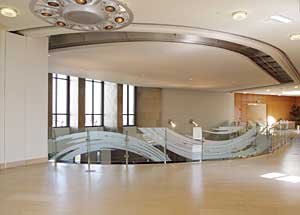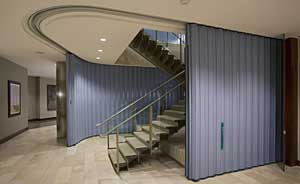Horizontal sliding-door Systems: Opening New Opportunities for Design Flexibility
At hundreds of Wal-Mart stores, the sliding-door systems serve as emergency egress in back storage areas. Some of the emergency exits are required to be in the back of the large stores, and in the event that front entrances are inaccessible, patrons need to be moved through the storage areas. But the storage and stockroom areas typically have high ceilings and require large openings to get products in and out; the sliding-door systems serve that function but also provide emergency egress and fire protection. The systems are in use at other large stores such as Nordstrom, Macy's, Target, and Sears, and also in smaller sales areas in stores such as Banana Republic or Brooks Brothers.
|
Designers of hospitals, specialized health-care facilities, and assisted-living complexes have also increasingly turned to the sliding-doorsolution, particularly as the design of interior spaces, whether expansive foyers, atriums, and gathering spaces that take advantage of natural lighting, has been linked to the psychological well-being of patients. The retractable systems facilitate interiors that are open and airy rather than stark and sterile. The same is true in educational institutions, where stringent fire and building code requirements can sometimes compromise architectural quality with unsightly permanent barriers. The systems are in use at university facilities from Harvard and Duke to Michigan and Stanford.
New applications are also seen in convention centers, theatres, parking garages, subway systems, and a wide variety of office buildings.
The Way They Work
Typically, horizontal accordion-style sliding-door assemblies are custom-designed to be stored in shallow recessed pockets in walls. These variations on the "pocket door" are best made to be consistent with the interior finish of the adjacent space, and stay in the closed, or recessed position, with the use of simple magnetic latches. The fire door is installed to ignore obstructions during the first few feet of closing to allow the pocket cover door to be pushed out of the way.
Some of the most important features concern electronic surveillance and power issues.
The door assemblies incorporate the use of a back up battery system, direct current (DC) motor and an integrated microprocessor to control the operation of the door during fire emergencies.
|
In a typical system, the 12-volt battery is continuously charged by the in-house 120-volt electrical system, and the microprocessor and logic board regularly supervise all critical operating functions of the door system, two and a half times per second. In addition, the system replicates a "loaded stress test" designed to simulate the voltage required to actually close the door during a real-life emergency. All fault signals are sounded audibly at the door location and can be communicated to a remote location in the building or to an off site central monitoring station.
The vertical "fire-exit-type hardware" attached at or near the leading edge of the door assembly and is programmed to respond to light pressure applied in the direction of exit travel. The building code requires that this force not exceed five pounds of lateral pressure. Upon activation the door assembly is programmed to retract a preset distance, typically 36 inches, pause for a moment, and then recycle close. If the door encounters an obstruction during the closing cycle it will stop, pause for three seconds and then continuing the closing cycle. At all times the door can be opened manually.











